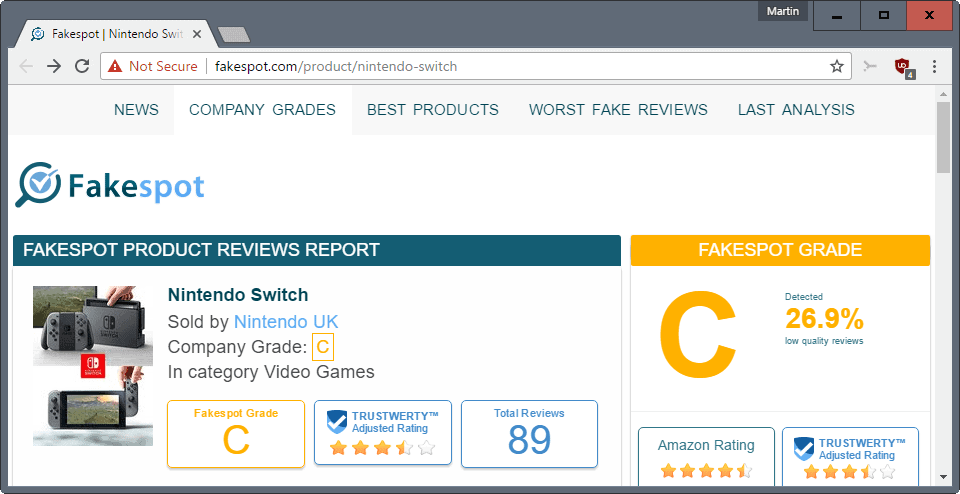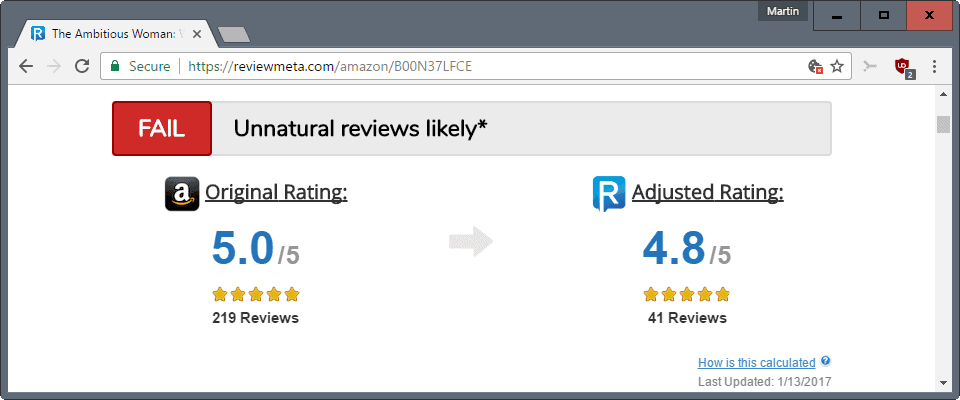Analyze Amazon reviews for authenticity

Shopping websites like Amazon support review systems that allow customers to leave reviews for products on the site.
Designed to add unique content and information to shopping sites, ratings are often also used when it comes to an item's visibility on a site.
Customers who buy online may rely on reviews more than they rely on product descriptions to make buying decisions.
This in turn makes it very profitable to push reviews for products. This is called fake reviews, and it usually involves someone paying reviewers to leave reviews on a shopping site.
Some sites may prevent anyone but customers who actually purchased an item from leaving reviews, but there are ways around this, for instance by handing out free samples.
Analyze Amazon reviews for authenticity
While it is often easy enough to spot fake reviews, as they tend to always give the highest rating and glorify the product, it has become more difficult in recent time to distinguish between legitimate and fake reviews.
This guide provides you with information on two Internet services that you can make use of to analyze Amazon reviews.
Fakespot
Fakespot is a free service that accepts any Amazon product or Yelp business link. Simply paste the link in the form on the start page, and wait for the analysis of the product to show up.
If the product is known already, results are displayed right away. If it is not, Fakespot starts to pull data from Amazon to analyze the reviews.
Fakespot grades the product reviews of the item, displays an adjusted rating, Amazon's rating, and provides you with information on the authenticity of the ratings.
It may for instance tell you that "there are indications of inauthentic/low quality reviews". The analysis digs deeper than that, as it provides you with information on the reviews.
It may give you words used to describe the product, the percentage of low quality reviews, and even information on inauthentic reviews, and why they were classified as that (automation, correlation with other fake reviewer profile data and languages).
Fakespot supports only Amazon.com, but no regional Amazon sites.
ReviewMeta

ReviewMeta works in pretty much the same fashion. Paste an Amazon url into the form on the site, and the program will start to analyze the product if it is not already in the database, or display results right away.
The service will adjust the rating and reviews based on its algorithm, display a report card that highlights checks the product reviews passed, failed or looked suspicious, and lists most and least trusted reviews.
What follows is a detailed analysis of all reviews. ReviewMeta lists the ratio of one-time reviewers to reviewers who have left multiple reviews on Amazon, the percentage of reviewers without any verified purchases, phrase repetition, and a lot more.
ReviewMeta supports regional Amazon sites.
Closing Words
Both Fakespot and ReviewMeta provide an interesting service that you can make use of to verify ratings and reviews on Amazon. While you can use it to authenticate reviews for any product that you are interested in, it probably makes the most sense for mid-price and expensive products considering that you will spend time using the services for each product you are interested in.























.
[ @ Former Amazon Reviewer: “I’ve reviewed several items on Amazon that I received for free, and I certainly gave my honest opinion on the product. The products I received, I truly liked them, therefore, I gave them a 4 or 5 star rating. And I did receive multiple products from the same company, but this in no way had an influence on my reviews. None whatsoever! In fact…” ]
…. well, your above post has little credibility.
Since the topic here is fake/biased Amazon reviews — why would we automatically accept your assertions as true and sincere ?
A person willing to fake Amazon reviews would also be quite willing to post deceptive comments here.
Also, you totally gloss over the highly suspicious fact that you were paid for your Amazon reviews with free merchandise. Even if you consider yourself an honest person, those payments very likely influenced you psychologically with a generally favorable view of the company/product. Just your acceptance of the review offer shows that you “trusted” the company to begin with.
Just how does one become a paid/compensated Amazon reviewer ???
( … what is the process — how is initial contact made between you and the product company.? What are the general terms of the agreement ? )
Yes, I agree with your concerns about @Former Amazon Reviewer.
Here’s a complaint from an Amazon seller – and the responses thereto are
quite interesting…..
https://sellercentral.amazon.com/forums/message.jspa?messageID=3360252
Here is an assessment I generated with Review Meta :
https://reviewmeta.com/amazon/0312630786
It’s interesting, because it helps understand what’s good and what’s bad about the service. I selected a controversial book about American politics, which is bound to attract very opinionated reviews from both sides, and also possibly reviews made in bad faith.
The assessment gives the same rating of 4,6/5 than Amazon, although it’s based on a subset of the reviews — the others are considered unreliable, I suppose. And it warns that there may be quite an amount of “unnatural reviews”.
Following the links, one sees very well why the flagged reviews were selected for unreliability. However, while in some cases the flagging is obviously justified (i.e., someone who did not buy the book from Amazon, is very opinionated, says very little and just echoes a review by a journalist he read on another site), in other cases it’s obvious that it’s unjustified : not having bought the book at Amazon does not mean it’s a fake review ; the critic may very well have bought it at another place, or borrowed it from a public library. Certainly those critics are very opinionated, but just reading some threads, comments by other users and the poster’s answers to the comments, then maybe the other reviews the poster has written about other products, you understand that this is the sincere (and useful) opinion of someone who has actually read the book.
On the other hand, this is interesting too :
https://reviewmeta.com/blog/review-brigades/
So while the exercise in computer programming might be interesting, the actual usefulness of the service is debatable. Maybe those services are essentially meant to detect completely unknown products by completely unknown vendors, with many reviews planted by the vendor himself. Such as those, presumably :
http://fakespot.com/worst-fake-reviews/most-recent
Not the most enthusiastic user of Amazon these days – they’ve been delegated to the bottom of my supplier list when they used to be top. Just too many concerns about their business/employment model.
Even so, it’s a pity the service doesn’t cover Amazon UK, where I’m convinced 50% of reviews are dodgy. But at least the more sensible among us are duly cautious.
But the reviews which really make me laugh aren’t deliberately malicious, just plain daft. Reviews which give 5 stars, then offer a variation on “Haven’t used/opened it yet but it’s so cool!”
Negative reviews should arouse caution too. Fom one dealer I found was rubbishing everyones’ product but his own – he couldn’t even be bothered to do more than cut and paste! To be fair Amazon descended on him fairly quickly once reported. To people giving one star because they haven’t the knowledge or perseverence to use a technical product. Including people who give one star simply because they couldn’t be bothered to read the description.
Personally I don’t do that many reviews any more because so many dealers are too demanding. I’ve had more than one get really demanding – insisting I replace a perfectly reasonable 4-star review with the 5-star rating they just knew they deserved. That usually results in a revised 3-star rating! Suppliers who remind me again and again that I haven’t reviewed get short shrift too.
The one thing I never ever review any longer is packaging. Most Amazon packaging is poor in my experience. But I stopped commenting, partly because it clearly had little effect, but mainly because I’ve heard that the info may be used to penalise already-stretched employees.
On the other hand Review Meta might be useful — I say might, because this would require much more thorough testing than I just did.
It’s as flawed as Fakespot in that it only accepts a product link as input, not a review link. However it does produced a detailed report leading to individual reviews considered as unreliable by the site.
It remains to be seen whether the algorithm used really allows to detect genuinely fake reviews (if I may use such a phrase), or merely unreliable ones, and also whether it avoids smearing legitimate or even useful reviews. Another step would be to compare the ease and speed of what you would do by yourself, just reading the original reviews, to what the site does.
I’m sick and tired of stupid sites and software. I’ve just tried Fakespot. It pretends to evaluate user’s reviews. You paste the link and it tells you.
So I pasted a few links of reviews of various products from various Amazon sites. I kept getting the answer : unrecognised URL. There’s nothing to tell you why it’s unrecognised, and there’s no help either.
Then I pasted a product link, and it worked. This is beyond stupid. Unless those sites address those who are so brainless as to be unable to make a judgement by themselves (and I’m beginning to think it might just be the case), the only time you want to use such a site is when you have a doubt about a particular review. It seems there’s no way to do that.
Now let’s have a look at what it does do. If you paste a product link, you get a judgment… about all that product’s reviews put together. How stupid is that ? How meaningful is it to say that put together, all the 40 reviews of a given product, in my test, deserve an A grade, and therefore “You can trust the reviews of this product” ?
Obviously, if there are fake or paid-for reviews on a product, they would be a tiny minority of the lot. The result of that “analysis” is already far less useful that what I could have done with my own head. Just reading the reviews will show up a certain number of them which, while not being outright fake, are not to be trusted, because too shallow, unfair or misguided for a number of reasons.
In this particular test, the site says : “Our engine has discovered that over 90% high quality reviews are present”.
Which means there are 10 % rotten, misguided or possibly even fake reviews. How useful is it to know that a well is “90 % not poisoned” ? Or you “only” have a 10 % chance to get ripped off if you trust one particular person ?
“Our engine has profiled the reviewer patterns and has determined that there is minimal deception involved.” Great ! I love it so much when people defraud me only a little !
You can ask to “see the full Trustwerty report”, which redirects you to one Trustwerty.com website, which has… no full report of any sort. All it says is : “From the 40 reviews, we have determined the Trustwerty rating to be 4.5/5.0 compared to the original rating of 4.5/5.0.”
And you get a link back to the product page of the site you were trying to evaluate, obviously in the hope that you’ll buy it and those “fake reviews detecting sites” will get a cut of your money.
How about a site detecting fake sites pretending to detect fake reviews ?
Amazon also has another annoying policy of linking reviews from multiple models of a product together. So if you look up something like a motherboard the reviews are from both good boards AND bad boards (e.g. one model is fine, but the other has a game-breaking bug but they both have the same reviews!). It artificially boosts the popularity of unpopular products by making it seem that they have as many reviews as the popular ones.
Big name tech sites aren’t necessarily trustworthy either. You just have to do the research if you want to know the facts.
When multiple items are lumped together – if you click on the model version just under the reviewer’s name, Amazon will then return reviews for that model only.
I’d advise everybody to use an oft-remarkable free software to that purpose, it’s called your head.
Amazon reviews are fantastic, and full of extremely knowledgeable people whose expertise wouldn’t be accessible otherwise. I’ll just give you an example. If you want to buy rechargeable batteries or a battery charger, look for NLee The Engineer’s reviews. Priceless. The same holds true for books, and countless other products.
I’ve reviewed several items on Amazon that I received for free, and I certainly gave my honest opinion on the product. The products I received, I truly liked them, therefore, I gave them a 4 or 5 star rating. And I did receive multiple products from the same company, but this in no way had an influence on my reviews. None whatsoever! In fact, I was told to give my honest opinions, good or bad, for the products I was sent. And I only accepted products for reviewing that had the high possibility of me liking it. If the product didn’t look like something I would like, I would decline to review it.
Here’s what Fakespot said of me.
Reviewer Analysis:
✓ Overwhelming amount of positive reviews
✓ Has done a total of 6 reviews for the same company
✓ Extremely positive reviews for a singular company
✓ Correlation with other fake reviewers’ profile data and language.
So, just because someone has given a lot of positive reviews, or did multiple reviews from the same company, makes their reviews untrustworthy? What a bunch of BS! You know what, a company could buy their own products from Amazon, or anywhere else, and leave positive reviews on it. This would show as a “Verified Purchase” on top of the review. Also, what’s to stop a competing company from buying products from their competitors, just to leave negative reviews on it? You see, how do we TRULY know that ANY review is legit or not? We don’t! You just have to go with your gut feeling about a product, which is what I have always done.
No doubt, there are some who probably have written dishonest reviews, but you know what, I am not one of them. I enjoy writing reviews and trying to help others. Some of us ARE honest!
“No doubt, there are some who probably have written dishonest reviews, but you know what, I am not one of them.”
These tools are hardly there to attack you personally, but there’s no doubt people like you skew the results. So yes, reviewers -like- you on average are a problem that these sites aim to negotiate around.
Methinks the laddy doth protest too much.
IF you have only six reviews on Amazon AND all for the same company, a wise person would come to the same conclusion, website assistance programs or not.
I often check the Reviewer’s other reviews and would reasonably conclude that six from six is dubious at best and not buy the product. Only a gullible fool would assume otherwise.
Ooops, make that “Rotten Scoundrel” seems “edit” can’t change the sign in.
Only Amazon.com or also .fr, .de, .co.uk, etc?
Fakespot only Amazon.com, ReviewMeta others as well.